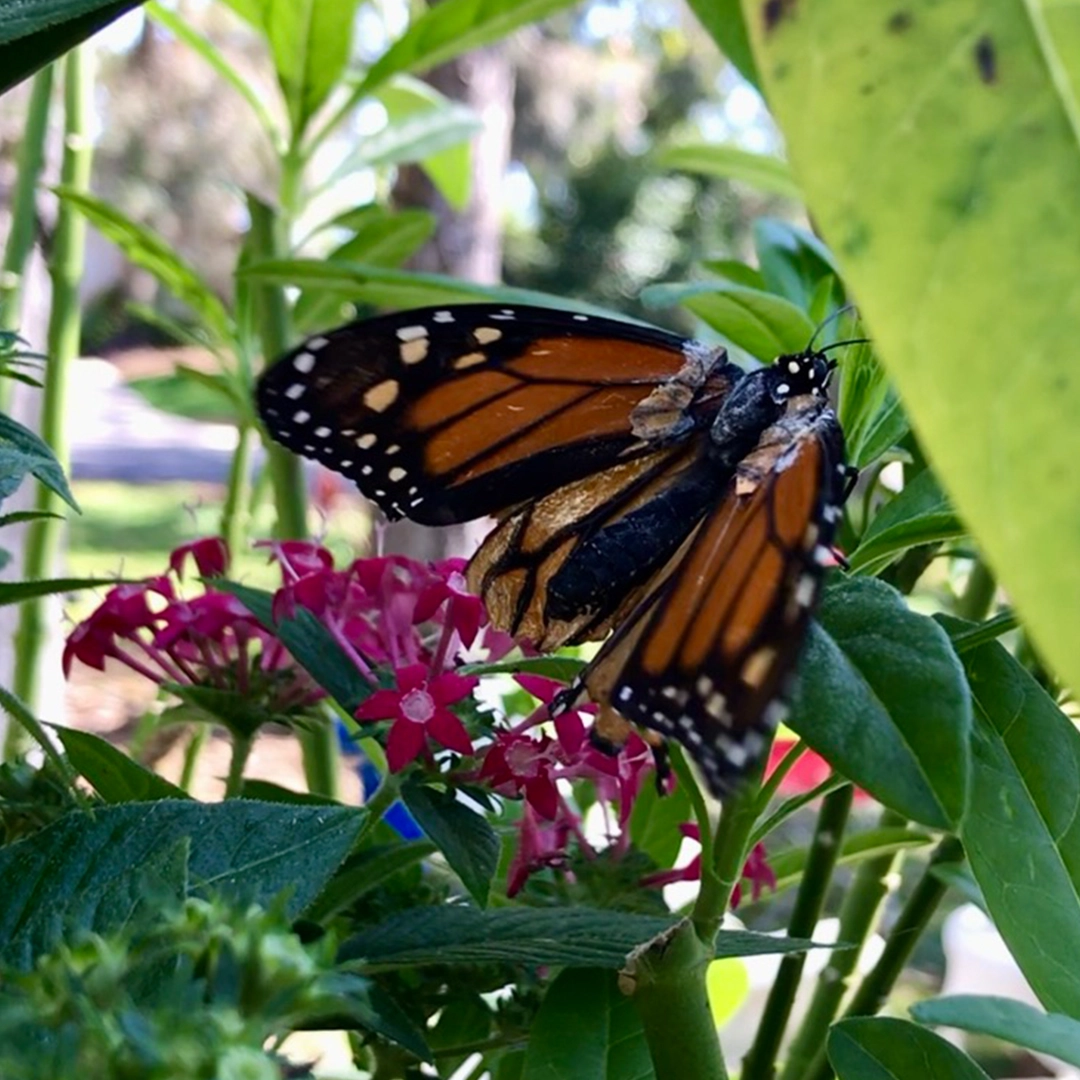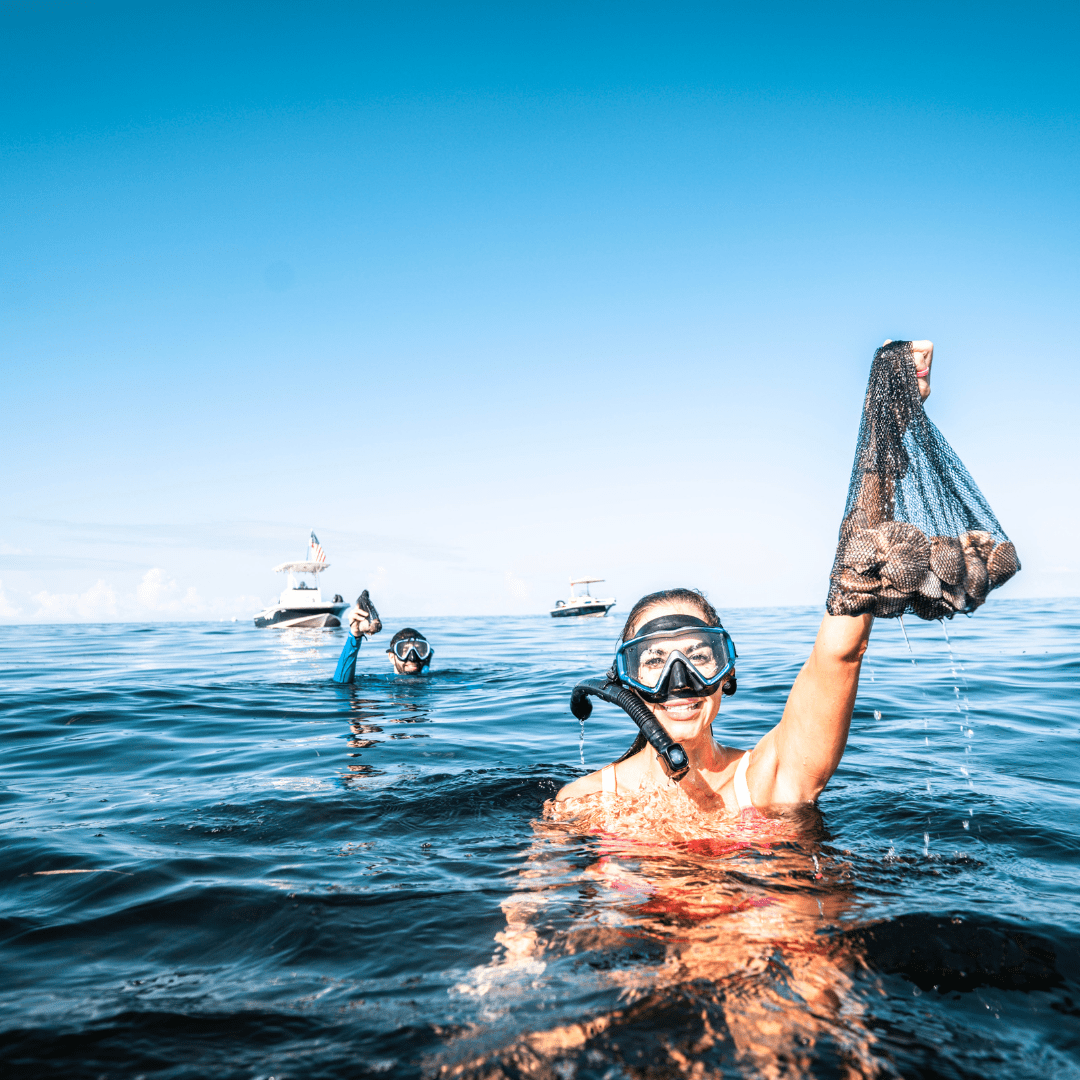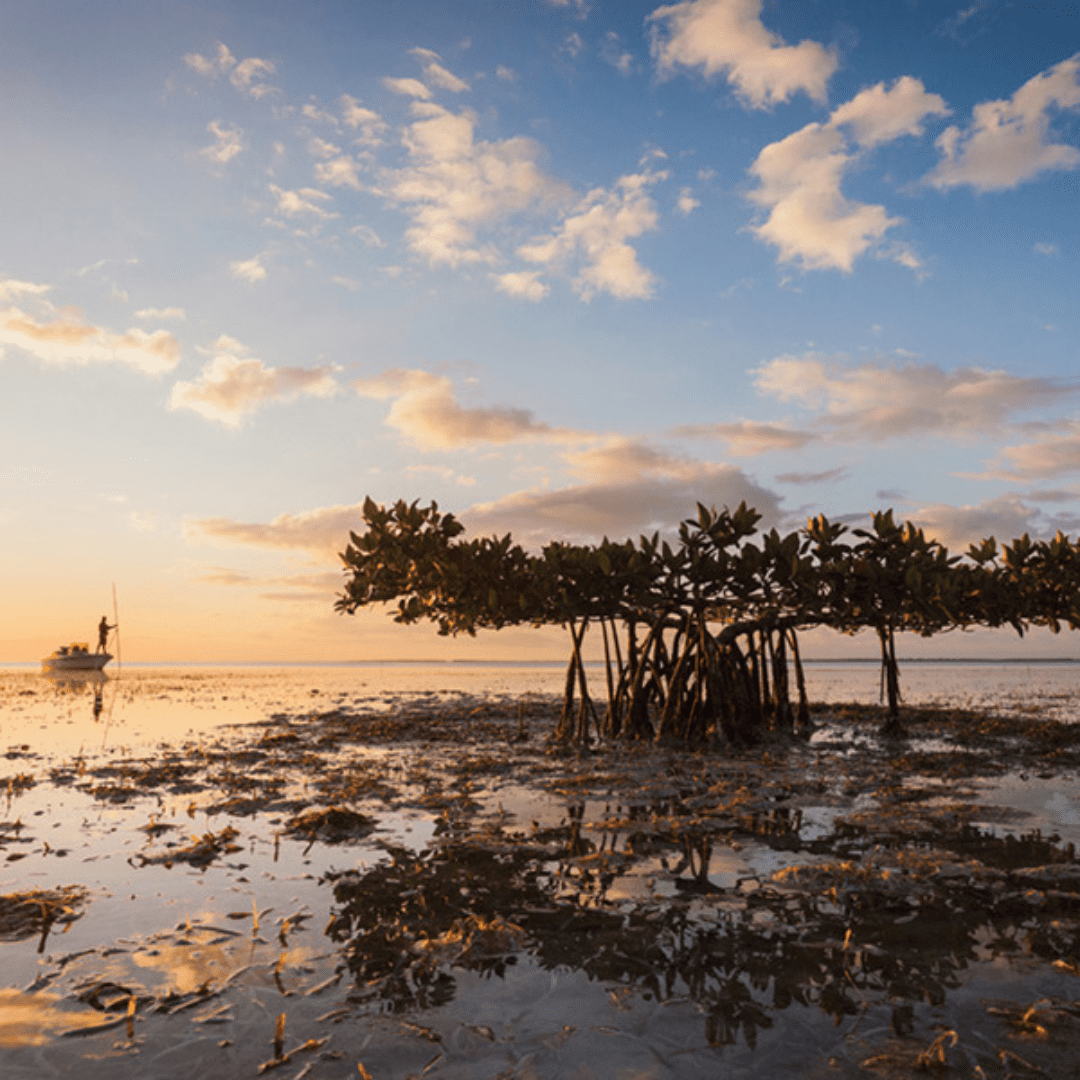by Steve Dollar | March 17, 2020
Meet the Farmers Leading an Oyster Revival on the Forgotten Coast
From the Panhandle waters, where wild oysters no longer flourish, a new breed of farmer emerges with the promise of a distinct Florida flavor and the hope of good fortune.

Although it is midafternoon in Panacea, the atmosphere is not quite the balm implied by the name of this coastal town, population 816, near the hinge of the Florida Panhandle. A thick fog hangs over Alligator Harbor, 20 minutes south of Panacea across Ocklocknee Bay off U.S. Route 98, and David Cowie is steering his 24-foot oyster boat straight into it. He motors across the flat, glassy surface of the water as it evaporates into the mist, the clouds hanging like puffs of dirty cotton. It’s a nautical canvas composed in impressionistic shades of gray, or else it’s a John Carpenter movie, and a phantom hook will all at once manifest out of the haze and sweep us—David, his father Preston and myself—into the aqueous beyond, with only the tall pines and gnarled water oaks to bear witness.
And that would really be terrifying—because we’d miss out on the oysters.
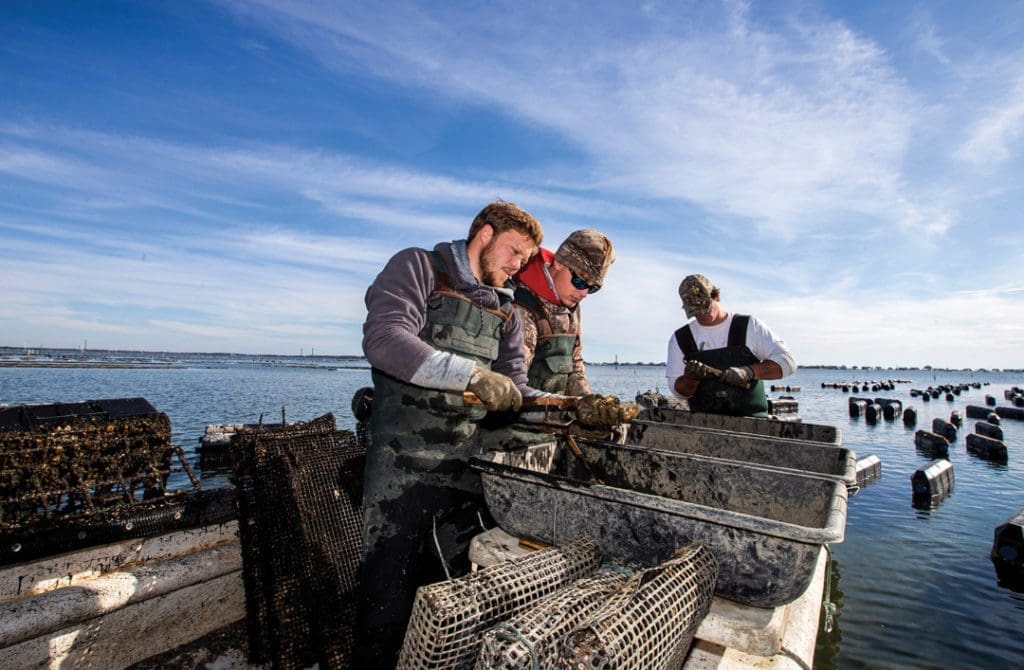
They’re out there, thousands of them, clustered in black polyurethane baskets strung in long rows in 80-foot-wide parcels. Sixty-seven of those parcels stretch across some 100 acres of the harbor that are leased by the state of Florida to oyster farmers. After a few minutes, we arrive at one of the sites, where David’s son Stone stands in another boat, hoisting “bags,” as they’re called, with his brother Hunter. This multigenerational crew is checking up on a maturing batch of oysters, which have been growing in the harbor since last July. The saline water is prized for the distinctive character it imparts to the oysters and inspired the name of the Cowie family enterprise: Semper Salty Oysters.
To prove the point, David empties out a basket of about 200 oysters onto a portable sorting table, digs through to find a keeper and pops it open with a knife. It’s a little soon yet, in mid-January. The shell is a bit thin, but the oyster is already as long as a thumb, and as meaty. I tip the shell back so the liquor washes over my tongue, as stimulating as a tequila shot, and the oyster slides fast behind, a brackish eruption that tastes like the day feels, all sea and brume and chill and mottled, monochrome sky.

Only a couple of years ago, the Cowies had other pursuits. Stone, 28, is a professional golfer. Hunter, 29, was moving furniture. David, 56, had been a first sergeant in the United States Marine Corps—hence the nod to the Marine Corps motto in his brand name—and went on to manage a branch of a satellite dish installation company. Preston, 80, was a retired insurance man. Between tournaments, Stone had been working for the Panacea Oyster Co-op, and talked his family into launching their own business.
“I realized [my boat] was the best office in the world,” David says. “I grew up always fishing and hunting and being outside. When I got out of the Marines I worked in an office and I thought, ‘I don’t like this too much.’ I love working out of a boat.” David also finds a different level of satisfaction when praise comes not from a corporate supervisor but a happy customer. “Your feedback doesn’t come for nine months, but for some reason when it happens it keeps you running for another year.”

The budding oyster industry became viable after the state allowed oysters to be farmed off-bottom or in what’s called the water column, where cages are floating on or submerged in the water. Prior to that, leases allowed farming up to 6 inches above the bottom of the water. Higher up, there is a richer supply of nutrients and fewer predators. Oysters can grow bigger and faster.
The Florida Department of Aquaculture has issued more than 700 leases of state-owned submerged land held by a variety of companies ranging from mom-and-pop farms to larger operations, with sites circling the state from St. Johns County to Escambia County. By one oyster farmer’s rough estimate, there are perhaps 40 outfits or individuals farming in Alligator Harbor alone. Much like Semper Salty, the farmers’ brands evoke a marshy “merroir”—a coinage based on “terroir,” which refers to the factors affecting the taste of wines—and entrepreneurial attitude in equal measure, with names like Saucey Lady Oyster Company, Outlaw Oyster Co., Oyster Boss, OysterMom, Pelican Oyster Company, Nature Coast Oyster Company and Wakulla Mystique Oyster Farm.

SECOND-ACT FARMERS
Wild oysters are harvested, not farmed. The resurgence of farming comes amid the collapse of an older, traditional wild oyster industry in Apalachicola that once supplied a tenth of the nation’s bivalves and 90 percent of Florida’s. The culprits are many. Hurricanes, overharvesting and ecological issues took their toll, but the worst factor has been the so-called “water war” between Florida, Alabama and Georgia. That feud goes back to the 1940s, when the U.S. Army Corps of Engineers began building a series of five dams that restricted the flow from the Apalachicola-Chattahoochee-Flint River Basin into Apalachicola Bay—water that wild oysters need to flourish. The case now is headed to the Supreme Court.
“It was booming back in the day,” says Reid Tilley, 24, who partnered with his father Jeff to launch Oyster Boss, a company that raises Alligator Harbor brand oysters in those namesake waters and also operates a processing center in Sopchoppy.
“If a gentleman wanted to make some money, he’d go out there and tong up some oysters and take them to a seafood house.”

No more. “It’s not a day-to-day paycheck,” Tilley continues. “You have to nurture the oysters, and plan well in advance the income you’re going to have until the oysters get up to size.
“There’s not a lot of opportunities in small-town America anymore. If you want a decent, good-paying job you’ve got to move to the city or an industrial area or be an entrepreneur.”
Even successful farmers face a long haul.
“Our best month has been 20,000 a week,” says Tim Jordan, 74, co-founder, with Walt Dickson, of the Panacea Area Oyster Company, purveyor of Saucey Lady oysters and a processing facility that serves many other farms. “Right now, we’re striving to hit 10,000. Hurricane Michael kicked our butts.”
Saucey Lady oysters are farmed in Oyster Bay, off Shell Point, where the salinity is lower than in Alligator Harbor. That accounts for what Jordan calls a “creamier” taste and texture, “not too salty but still salty.” Salt level is but one of multiple factors that determine how an oyster turns out. Heat, nutrient levels and the technique used to grow the bivalves all come into play. “That’s what’s so wild about oyster farming. You can have two oyster farms side-by-side and the [oysters] still will be unique.”

The romance comes at a premium. The labor is intensive, high risk is only a hurricane away and profit can be wishful thinking. “It’s a hard way to make a living,” says Jordan, joking that he’s heard some of his peers refer to themselves as ranchers.
“I don’t think anybody’s made much money. We’re going to have to get really efficient and learn how to do it.”
Jordan, who once made his living selling produce, got into oysters six years ago when Tallahassee Community College initiated a one-year aquaculture program run by its Wakulla Environmental Institute in Crawfordville, where Jordan’s wife was a coordinator. If you meet someone farming oysters in the Panhandle, they are probably one of its graduates, who number around 120.

Jennifer Fountain is one of them. She started the WEI class in September 2017 and harvested her first oysters the following spring, operating under the school’s lease. Fountain’s family has owned a house on St. Teresa Beach, about an hour south of Tallahassee, since the 1930s, “right there by the oyster and clam leases,” so life on the water is second nature to her. Her husband has a full-time job and her children are older, which allowed the former stay-at-home mom to take on a new challenge. “I’m trying to stay afloat out there,” says Fountain, 45, who markets her oysters under the name Nature Coast. “Just being out there on the water, it’s a purpose.” Fountain’s is one of the smaller operations in Wakulla County, although she emphasizes quality. “I take a lot of pride. I’m a meticulous person. My oysters, I try to baby them.”
Even though wild oystering is a male-dominated industry, oyster farming draws more women to its ranks. Deborah Keller, another aquaculture student turned farmer, christened herself “Oyster Mom” and sells oysters under the brand. Outlaw Oysters, one of the larger outfits in Panacea, is owned by Denita Sassor and her partner Blake Gardner. Sassor estimates they move between 20,000 and 30,000 oysters a week, bolstering the income they make as regional dealers of oyster farming equipment. “You can be respected for what you’re doing,” she says. “Luckily, it’s an industry that either one [man or woman] can do.”

Asked about her experiences, Fountain has to laugh. “In the summertime, me and my friend were out there in our bikinis working, so I guess we get a little more attention than the guys there,” she says, drawing a contrast to the beer commercial imagery of bare-chested men hauling cages out of the water. It’s the same effect when Fountain is hauling a boat behind her macho Ford F-350 truck. “People know who we are.”
In the coming years, Fountain and her fellow farmers can expect a lot more company on the water, thanks to the Wakulla Environmental Institute.
TINKERING WITH TASTE
“When you get done you know more about oysters than you ever thought,” says Bob Ballard, the institute’s executive director. That sentiment includes Ballard, as well, a former deputy secretary of land and recreation for the Florida Department of Environmental Protection who developed the aquaculture program from scratch after local residents signaled a need for it. The institute, housed since 2016 in a unique, eco-friendly building on a wooded compound in Crawfordville, also offers programs in agriculture, conservation and drone technology. It’s the aquaculture classes, though, that have made the most social impact, fostering the promise of a return to the glory days when the oyster ruled the coastal counties of Wakulla, Franklin and Gulf. The nighttime sessions draw their share of students who have long made their income from the water, which could be expected. Ballard was surprised, however, when half the enrollment came from state workers from Tallahassee, retired or close to it.
“They’ve been behind a desk all their life, and now they want to get out in the wild,” he says. “This has been a fantasy for them. They turn out to be really good students.”
Ballard called on former Gov. Rick Scott to expand aquaculture leases to include the full water column in 2013, which allowed oyster farming to take over from wild oyster harvesting. He refers to his students as “pioneers,” and brings an inventor’s spirit to his mission. He’s seeking a patent for a device—an “oyster dome” made of high-strength concrete—that he believes can regenerate the state’s native oyster population, which in turn could trigger a domino effect of ecologically positive results. “It may take five years. It’s not a light switch,” he says, but if his plan succeeds, the outcome could be a dramatic response to Florida’s plague of red tide. “Red tide skipped over Wakulla County. You put out the oysters and red tide will go away. One oyster filters 50 gallons of water a day.”
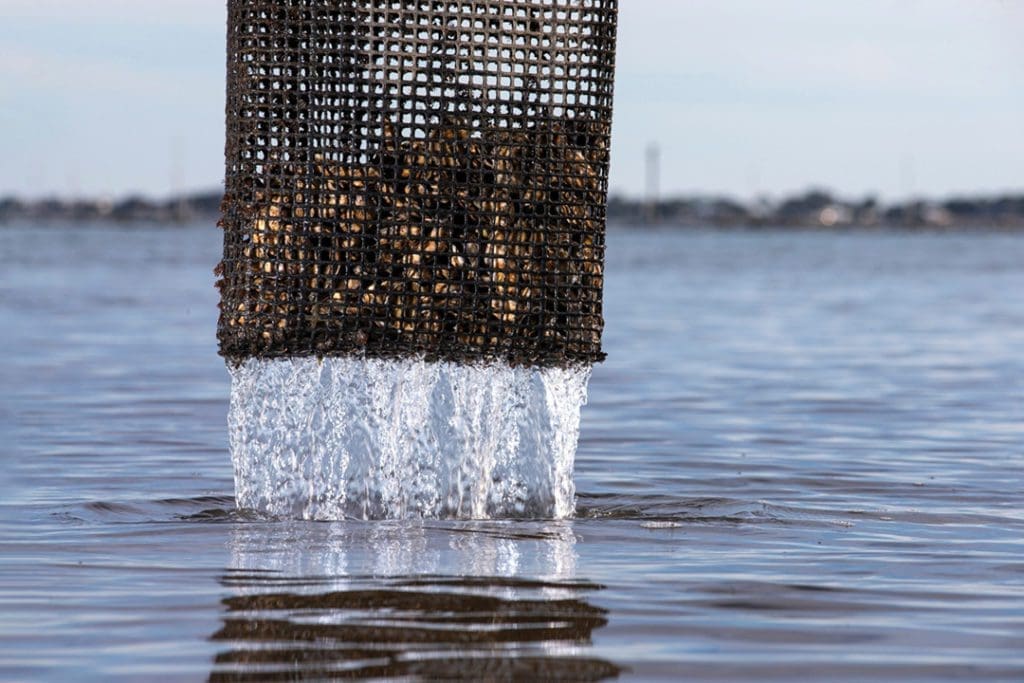
When someone sits down with a cold beer, a slice of lemon and a bottle of hot sauce to sample a dozen raw oysters from Alligator Harbor, Oyster Bay or Skipper Bay—the three main oyster farming spots near Panacea—what they are tasting is a work in progress. “It’s a bit of a saga to get this decoded and figure out how Mother Nature wants to do this for us,” says Jeff Tilley of Oyster Boss. “An industry needs to improve to be healthy, and there’s only so much [money] we can get at the wholesale level.” To produce more oysters, to meet a demand that outstrips supply, to boost the odds of an oyster surviving from seed to saltine cracker, Tilley emphasizes the need to use science. After suffering “stout losses” in some early harvests, he convinced a breeder to tinker with his Alligator Harbor brood stock and got dramatic results.
“An 80 percent success rate,” he says. “I’m becoming quite optimistic that maybe an improvement on the genetics has unlocked what we need on the north Gulf Coast.”
American shellfish hatcheries date back to the 1970s, according to Bill Walton, an associate professor at Auburn University’s Shellfish Lab on Dauphin Island, Alabama. Oyster farming took off in the ’90s.
“Our region is behind because we’re the part of the country that still had abundant wild oysters,” he says. “It’s tremendous to see Florida come on board and grow quickly.” Soon, all five Gulf Coast states will be in alignment. Alabama, Mississippi and Louisiana have smaller aquaculture industries, and Texas just passed legislation to authorize its own off-bottom farms, which Walton expects will be in business by this time next year.
“The analogy here is microbrews,” says Walton, also known as “Dr. Oyster,” who suggests that there are different markets for wild and farmed
oysters, and plenty of room for both. “Maybe we should build on the fact that we have this amazing, quality, fresh seafood that is harvested sustainably from water that is well regulated. Florida is absolutely capable of producing world-class oysters at these farms. It’s only a matter of time before you see these oysters on menus in New York or Boston or Washington or Chicago.”

Reid Tilley remembers his first time sampling an oyster. It was at his father’s hunting club. “Old dudes standing around a tailgate popping these rocks open,” he says. “I was 6 or 7. My dad handed me one on a cracker, and I thought, ‘Man, that does not look appetizing.’” As he got older, Tilley acquired a taste for them. “Now I’ve eaten so many I could care less to eat another one.”
Nonetheless, Tilley describes the appeal of the classic Apalachicola oyster to a tee. “The first part is you get that hit of salt, and at the end, you chew it up, and the sweetness comes up out of it. Just a hint of sweetness at the end.”
Although oysters are harvested all along the Gulf Coast, and across Florida, Tilley and his neighboring aquaculturists are fortunate to be farming exactly where they are, a place that imbues their oysters with something extra.

“The key is water quality,” Reid Tilley says.
“The Panhandle is literally the last stretch of coast that has not been turned into a heavy-duty residential-commercial area.”
Fewer people means less wastewater and pesticide. “There’s not that many lawns.” Tilley is wary of a population surge that could threaten his livelihood. “More and more and more people are coming. It’s only a matter of time,” he says. Time enough, anyone might hope, for the Lost Coast’s fabled shellfish to again find something like perfection.
Last spring, Tilley and his father participated in the Billion Oyster Party, a charitable gathering at the Liberty Warehouse in Red Hook, Brooklyn, to benefit restoration efforts in New York Harbor.
“There were 50 farms from all around. The Pacific, Atlantic, Gulf, Alaska. Hundreds of oysters. I couldn’t find one, and maybe I’m biased,” Tilley says, “but I couldn’t find one that tasted nearly as good as the Florida Panhandle
oyster like we grow.”

